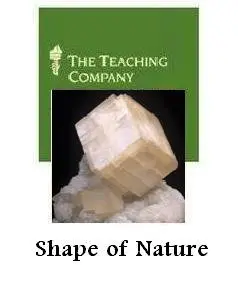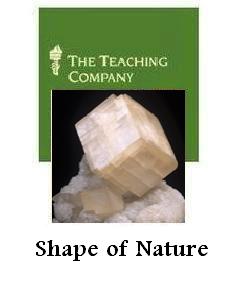Shape of Nature ( Video Lectures )
English | XVID 640x480 29.97fps 841kbps | Mp3- 128kbps | 7.59 GB | (36 lectures, 30 minutes/lecture)
Taught by Satyan L. Devadoss | Williams College | Ph.D., The Johns Hopkins University
How do you measure the size of a black hole? The motion of individual particles at the subatomic level? The possible shape of space-time itself?
In short: How do you mathematically describe the world around you?
The answer lies in the fascinating ways mathematicians use geometry and topology to study and understand the shape of nature, whether leaf formations, DNA entanglements, or quantum fields. Mysterious, complex, and undeniably captivating, the study of the shape of nature lies at the forefront of current research in both mathematics and science. What's more: It's provided us with previously unimaginable scientific and technological advances, including our ability to
* read genetic data to better determine the relationships between species;
* closely study how proteins are built through the intricate process of folding;
* model and predict wind currents around the globe;
* map the seemingly random terrain of vast mountain ranges;
* develop facial recognition software for cameras and high-level security systems; and
* design and improve the way that robots move and behave.
While the mathematics involved in the study of shapes and nature is important to how we grasp and live in the world, it remains a mystery to many of us. But these concepts and ideas are not completely inaccessible. All you need is the right guide and an engaging way to approach the subject—both of which are available in The Shape of Nature. This visually stunning course is your authoritative guide to the mathematical shapes around us: how they're formed, how they're studied, and how they're applied to our everyday lives.
In 36 lectures, you'll discover the intricate relationship between mathematics and nature, get a pointed introduction to the language mathematicians use to study shapes and dimensions, and learn how to finally make sense of this abstract—yet undeniably intriguing—subject. And it's all brought to you by award-winning Professor Satyan L. Devadoss of Williams College, a dynamic instructor with an abiding and contagious passion for the worlds of geometry and topology. His clear and engaging presentation style, accompanied with eye-catching animations and graphics, will make your journey into the world of shapes both insightful and unforgettable.
Explore Fascinating Shapes
The vibrant heart of The Shape of Nature lies in its spirited exploration of the world of shapes. And the secret to understanding how shapes are created and how they work involves two powerful mathematical fields:
* Geometry, the ancient discipline that focuses on quantitative notions such as the length, area, and volume of a particular shape
* Topology, the modern field that focuses on qualitative notions such as connectivity, underlying structures, and the relationships between shapes
After an engaging introduction to these two fields and their critical role in understanding shapes, Professor Devadoss takes you deep into the four main categories of shapes. Each category occupies its own particular dimension, has its own unique characteristics, and plays an important role in the worlds of physics, biology, and chemistry.
* Knots: Begin your journey by learning about the simplest of shapes, the knot. Defined as circles placed in 3-D, knots appear throughout the world in DNA, in string theory, in knotted molecules, and in genetic mutations. These shapes serve as a jumping-off point from which you examine other simple shapes, including tangles, braids, and links.
* Surfaces: Surfaces are the most common shapes in nature; essentially everything you see is the surface of some object, and these shapes are involved in everything from origami designs to wind flows to colored patterns on animals. Among the surfaces you study in this group of lectures are spheres, the five Platonic solids (the tetrahedron, cube, octahedron, dodecahedron, and icosahedron), the Klein bottle, and the projective plane.
* Manifolds: Also known as 3-manifolds, these shapes are fascinating 3-D objects that can be finite or infinite in volume; can have boundaries or be without them; and can be orientable or non-orientable. As you move through these beautiful and complex shapes, you learn how to build them using simple operations such as multiplication and gluing and discover how they are instrumental in understanding the topology of the universe itself.
* Higher dimensions: Leave the comfort of three dimensions and enter worlds that stretch our imagination. The 4-D polytopes are considered higher-dimensional analogs to the Platonic solids, including the famous 120-cell polytope (made of dodecahedra), the 600-cell polytope (made of tetrahedra), and the associahedron—the most influential shape of the last 25 years. Then move to arbitrary dimensions and enter the inner workings of particle collisions, robotic motions, genetic evolution, and more; even fractals and chaos theory make an appearance.
With each of these categories, you learn methods for building these shapes, the ways they relate to one another, the important theorems and ideas that advanced our understanding of how they look, and more. Professor Devadoss, an expert at making the theoretical practical, takes care to guide you through this challenging and rewarding mathematical territory with detailed explanations, stunning examples, in-studio demonstrations, and helpful summaries, so that while the shapes are challenging and require a deep interest in mathematics, you'll never feel overwhelmed by what you're learning.
Discover New Mathematical Ideas and Tools
Because The Shape of Nature tackles pioneering concepts in mathematics, it also serves as a powerful introduction to the revolutionary ideas and tools that modern mathematicians use to understand and work with shapes. In addition to helping you make sense of concepts such as equivalence, isotopy, and homeomorphism, Professor Devadoss demonstrates some of the many intriguing theorems and devices that have vastly expanded our understanding of shapes and the natural world.
These include
* the Poincaré conjecture, the milestone in mathematical thought that helps mathematicians distinguish spheres from other manifolds;
* Voronoi diagrams, which aid in analyzing and interpreting the areas of influence that emerge from clusters of objects known as point clouds;
* the Jones polynomial, a powerful polynomial that, so far, has been able to distinguish any knot from the unknot and is related to the ideas in string theory;
* the Seifert algorithm, a famous algorithm that, using any given knot, is able to build an orientable surface whose boundary is that knot; and
* Dehn surgery, a method of cutting, twisting, and gluing manifolds to form new ones.
Learning about the techniques involved in the study of nature's shapes will not only give you a thorough grasp of the world of topology, it will round out your understanding of the mathematical world by introducing you to the mathematical issues and concepts of the last quarter-century.
Enter a World of Mathematical Mystery
What makes The Shape of Nature so engrossing and accessible despite the complexity of its subject matter is the undeniable passion and teaching skills of Professor Devadoss. Adept at bringing to life the fascinating world of shapes and explaining the mathematics behind them, he makes each lecture a joy to listen to. In addition, the eye-grabbing animations and visual demonstrations that flavor these lectures—many crafted by Professor Devadoss himself—bring the multidimensional wonders of the world to vivid life.
"It's amazing how much nature holds in her mysteries," Professor Devadoss remarks with his characteristic excitement and enthusiasm. And by the concluding lecture of The Shape of Nature, as you bring to a close your journey through this mathematical territory rarely charted for the average individual, you'll undoubtedly find yourself nodding in agreement.
Fileserve Links
http://www.fileserve.com/list/bFE5WPt
Filefactory Links
http://www.filefactory.com/f/1a841b27bea94cf6/
Hotfilelinks
http://hotfile.com/list/874403/0d319fe
No Mirror Please



